8 Yoga Poses for Anxiety Relief
This article originally appeared on Yoga Journal
I've had generalized anxiety disorder for most of my life. While I'm a big believer in therapy and pharmacology, yoga has also been a powerful tool. I notice a tremendous difference in my nervous system on the days when I move my body versus the days I don't.
We often think of anxiety as fear of the unknown future. Dr. Becky Kennedy, author of Good Inside, explains that anxiety is actually less about our fear of what may happen and more about our fear that we won't be able to handle that circumstance. I love this reframing because it reminds us to reclaim our power. When I think back on all the things I have weathered in my life, I see just how resilient I am. That gives me more confidence that I can handle whatever comes my way. This lesson is reinforced on my yoga mat where I can explore my edges kindly and learn how to pick myself up again and again if and when I fall. It is a place where I can face my greatest anxieties and fears head on.
Here is a sequence that takes an anxiety-busting approach to some of our favorite and most familiar poses. Practicing yoga for anxiety can help us feel courageous and resilient again.
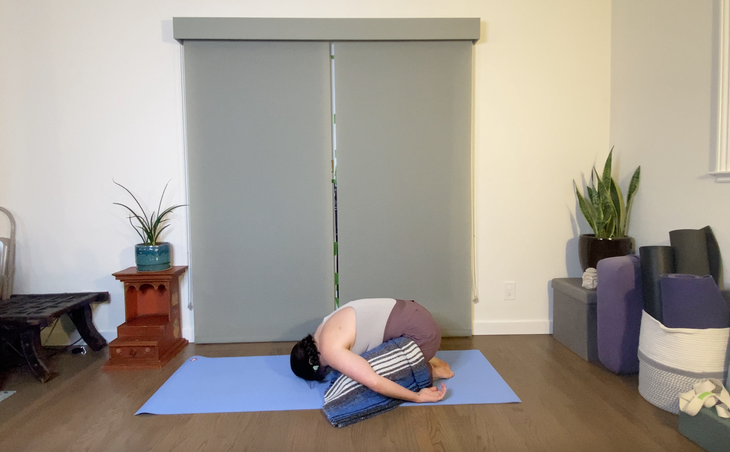
1. Balasana (Child's pose)
When we are feeling anxious, there can be an impulse to curl in and hide. Freeze is one of our primal responses to attack, so it makes sense that we feel that way. On more anxious days, I like starting in Child's Pose because it embraces the "freeze" impulse. Rather than throwing my body into the gauntlet of opening up, I curl up small to send my body and nervous system the message that we are meeting each other where we're at. Nothing is being forced; nothing is to be feared. This variation uses a rolled blanket to create an anchoring sensation and to invite tight hip flexors to release. (Gripping in the tops of the thighs is a common physical response to stress.)
How to: Come onto your knees. Bring your big toes together and separate your knees. Grab a blanket or towel and make a small roll on one edge (about one inch in diameter) and place it in the crease where your thighs meet your pelvis. Allow the rest of the blanket to lay on your lap. Take a big inhalation and, as you exhale, fold over to come into Balasana pose. Reach your arms out in front of you alongside your ears or back toward your feet. You may want to place a block under your forehead. Remain here for 10 long breaths.
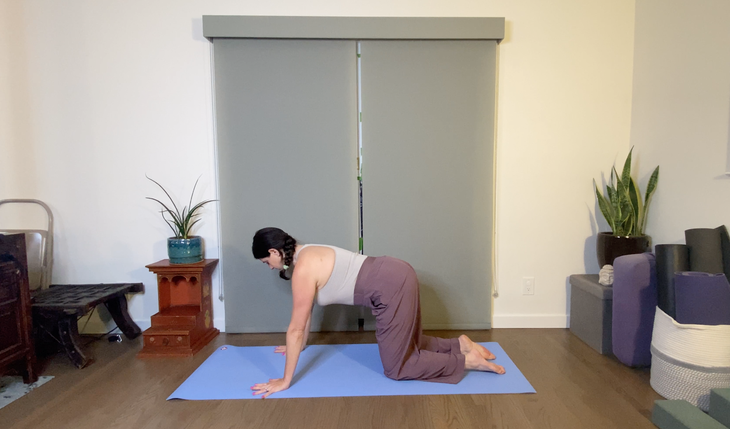
2. Marjaryasana/Bitilasana (Cat/Cow Pose)
This pose combination has a number of specific benefits for this sequence. First, movement is a lovely way to get the breath flowing. When we're anxious there is a tendency to hold our breath. Second, it's a familiar pose because it's practiced so often in yoga classes. Familiarity can feel comforting and supportive. But we're going to add in a third step for an additional benefit. Once you've completed a full round, pause with a neutral spine for an entire breath. This represents finding that place of presence between the future-facing, open-hearted Cow and the recoiling, protective energy of Cat.
How to: From Child's Pose, inhale and come into Tabletop position. For this practice, keep your hands slightly in front of your shoulders, so you can really feel the movement of your spine. On an inhalation, lift your chest and arch into Cow. On an exhalation, press your palms strongly into the floor and dome your back into Cat. Now come into a neutral spine, where you are neither arched or rounded. Pause here for a full breath cycle. On the next inhale, return to your dynamic Cat/Cow. Repeat this full sequence (with the pause in between rounds) for five cycles.
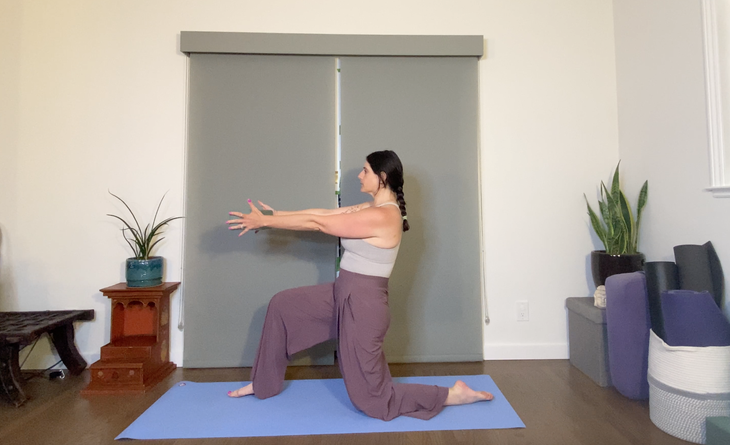
3. Low Lunge variation
Our body often speaks our feelings even before we have had a chance to process them. When we're anxious, it can feel like we're bracing for action. We may unconsciously puff our ribs forward and jut out the chin, as if ready to pounce or run (think fight or flight). Holding a block in front of you can help guide the body back to center. It is an opportunity to practice drawing our front body in toward our back body, integrating into the moment.
How to: From Tabletop, step your right foot toward the front of your mat and align your front heel under your knee. Pad your back knee for comfort. Grab your block and lift your torso upright. Hold the block between your palms and reach your arms in front of you, away from your body, in line with your chest, and parallel to the floor. Use your exhalation to draw your front ribs back away from the block, as if you could move your front body to your spine. Widen your collarbones, relax your shoulders, and reach through the top of your skull. Do this for five breaths, keeping the block chest high. Place your block back onto the floor and return to Tabletop before repeating with the left foot forward.
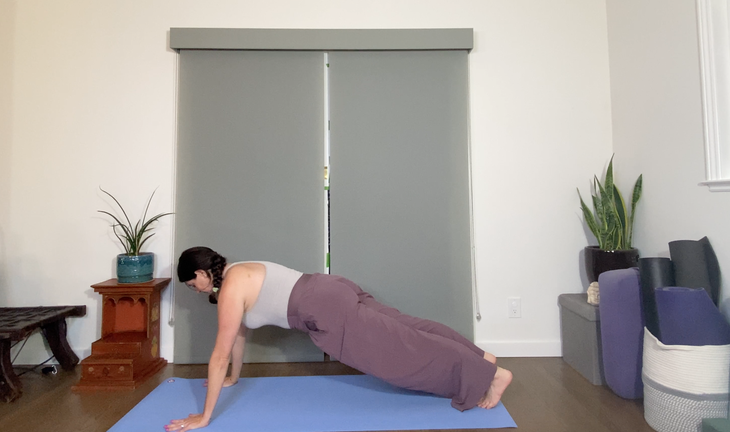
4. Plank Pose
It can be easy to practice yoga in a calm space like in the yoga studio or on our mat at home. But what happens when we are in the real world and intensity is heightened? Well, Plank offers us the best of both worlds. We can observe that same "sandwiching" of our front ribs toward our spine that we practiced in the lunge, but in a much more intense moment. Yet because it is still a yoga pose at the end of the day, we also know we are held and protected by our mat.
How to: From Tabletop, step your feet toward the back of your mat, straightening your legs and coming into Plank position. If Plank feels too intense, place your knees down behind your pelvis in a supported variation. Press your palms into the floor and practice the sensation of lifting your front body into your back body as you did in the Low Lunge. At the same time, reach your crown away from your heels to lengthen your spine and mitigate any rounding. Stay here for five to ten breaths.
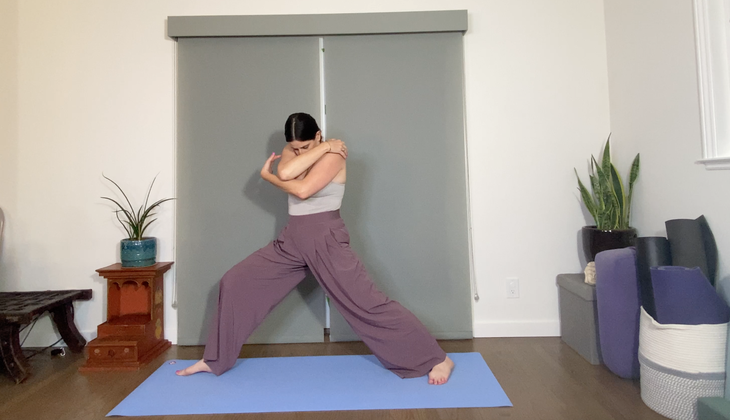
5. Virabhadrasana 2 (Warrior 2 Pose), variation
One of the key features of anxiety is the desire to fold in upon ourselves. Evolutionarily, defending the belly is a way to protect our most vital organs-and we honor that. This variation of Warrior 2 encourages us to open up from the inside out. We will wrap our arms around ourselves as a symbol of the comfort and protection we seek, but we will also work to find length and strength within the shape.
How to: From Plank, bend your knees, walk your hands to the back of your mat, and slowly come up to standing. Come to the middle of your mat and face the long side, stepping your feet a few feet apart. Turn your right leg out, so your toes face away from your body, and turn your left foot and hip slightly inward. As you exhale, bend your right leg, aligning your knee either behind or over your ankle. If your knee is bending well beyond your foot, lengthen your stance. Inhale and raise your arms into a T-shape. Exhale, round your spine and wrap your arms around your chest, crossing at your elbows to give yourself a hug. Stay in the shape for five breaths but use every inhale as an opportunity to expand. After your final breath, release your arms, turn your feet parallel, and set up for your left side.
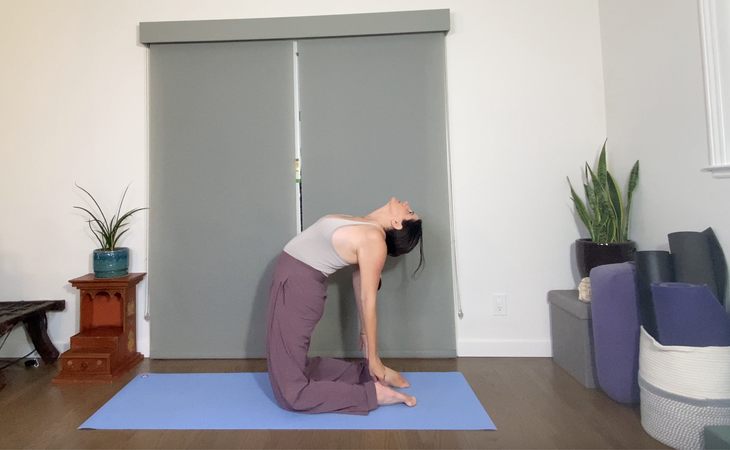
6. Ustrasana (Camel Pose)
Backbends such as Camel or Standing Drop Backs, which involve arching back from an upright position, may be some of the most powerful poses for teaching us how to have faith in the unknown-and in ourselves. They teach us how to find equilibrium so we don't fall. If we do fall, we trust we'll be able to get up and try again-and still love ourselves all the same.
How to: After the Warrior 2 sequence, you may consider doing a Surya Namaskara A from the front of your mat to help reset the body after such asymmetry. Otherwise, come directly onto your knees for Ustrasana, separating your legs and feet hip-width apart. Bring your hands to each side of your sacrum just at the top of your buttocks and point your fingertips down. This helps open the chest more by enhancing the external rotation of our upper arm bones. To add more challenge to this Camel, close your eyes or, if that's too uncomfortable, lower your eyelids and look toward your cheeks. On an inhalation, lengthen your spine from tail to crown; on your exhalation, start to arch back toward Camel Pose. You may take your head back or keep your chin to your chest if you have any neck discomfort. Breathe here for five full breaths. Keep your eyes closed as you press into your shins and inhale to lift your spine back to upright. Sit back on your heels and pause for a few breaths before repeating one more round.
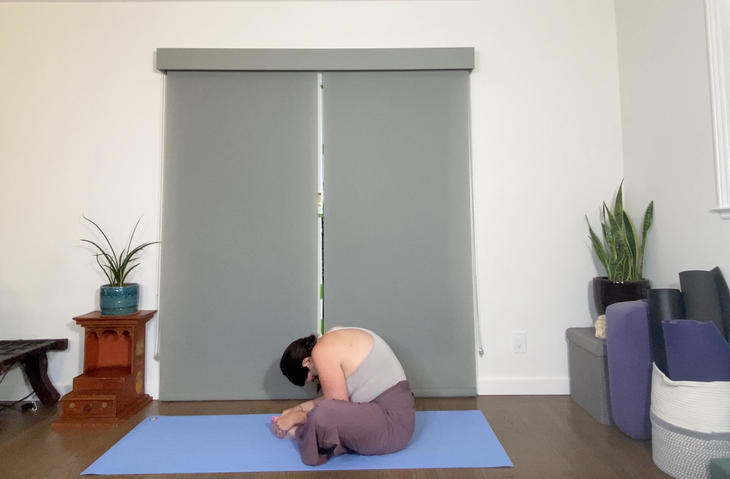
7. Baddha Konasana B (Bound Angle Pose B)
Our heart is another source of courage. The Latin root word for courage is cor-, which translates to 'heart.' As the saying goes, courage is not an absence of fear, but a doing something despite the fear--an important adage to remember when we're experiencing anxiety. Practicing a more rounded version of Baddha Konasana allows us to take a gaze inward upon the symbolic cave of our heart. Many ancient teachings talk metaphorically about this space containing an ever present flame. This flame can light even the darkest paths we must traverse. On a physical level, this pose releases all the muscles along the spine, upper back, and neck, all of which tend to grip when we are under stress.
How to: Come to sit with your legs in front of you. Bend your knees, open them out wide to the sides, and touch the soles of your feet together. Pull your heels toward your pubic bone. Holding your feet with your hands, take an inhalation, and on an exhalation, round your spine as though you could touch your forehead to the bottoms of your feet. Allow the rounding to originate from your tailbone and come all the way up to the base of your skull. Stay here for 10 breaths, breathing into the back of your rib cage and upper spine. On an inhalation, slowly come upright. Bring your knees together and stretch your legs straight.
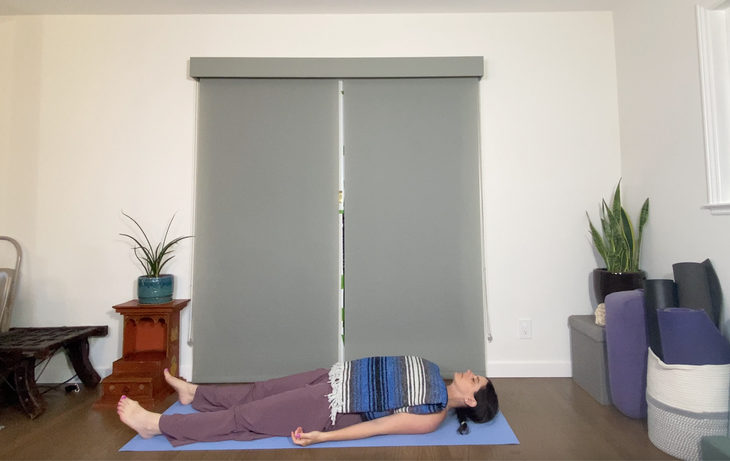
8. Savasana (Corpse Pose)
When we're ready to face whatever comes our way, there can be a level of excitement. We don't want to encourage the kind of "bring-it-on" energy that sometimes leads to making decisions prematurely. This version of Savasana, using a blanket as a weighted anchor, allows us a moment to pause and ground in the present. By accepting stillness after such a dynamic sequence, we are able to notice what it feels like to be ready to move without having to act.
How to: Grab a blanket and fold it so that it is a heavy square. If you have thin blankets or towels, you may need a few to create some weight. Lie down and place the folded blanket over your chest. It should cover you from your shoulders down to your waist or below. This will help to release the shoulders toward the floor. Close your eyes or simply lower your eyelids and soften your gaze. Remain here for a minimum of three minutes. Always rest longer if you are able.
When you're ready, remove your blanket, roll to one side and press up to a seated position. Pause here in the present moment and honor the things that made it possible for you to do this practice today. Observe the effects of your work.
More Practice Rx Sequences:
When You're Afraid: A Practice for Anxiety Relief
When You Need a Boost: A Practice for Energy
When You Feel Scattered: A Practice for Grounding
When You Need to Reset Yourself: A Practice for a Fresh Start
About Our Contributor
Sarah Ezrin is an author, world-renowned yoga educator, popular Instagram influencer, and mama based in the San Francisco Bay Area. Her willingness to be unabashedly honest and vulnerable along with her innate wisdom make her writing, yoga classes, and social media great sources of healing and inner peace for many people. Sarah is changing the world, teaching self-love one person at a time. She is also the author of The Yoga of Parenting. You can follow her on Instagram at @sarahezrinyoga and TikTok at @sarahezrin.
For exclusive access to all of our fitness, gear, adventure, and travel stories, plus discounts on trips, events, and gear, sign up for Outside+ today.

